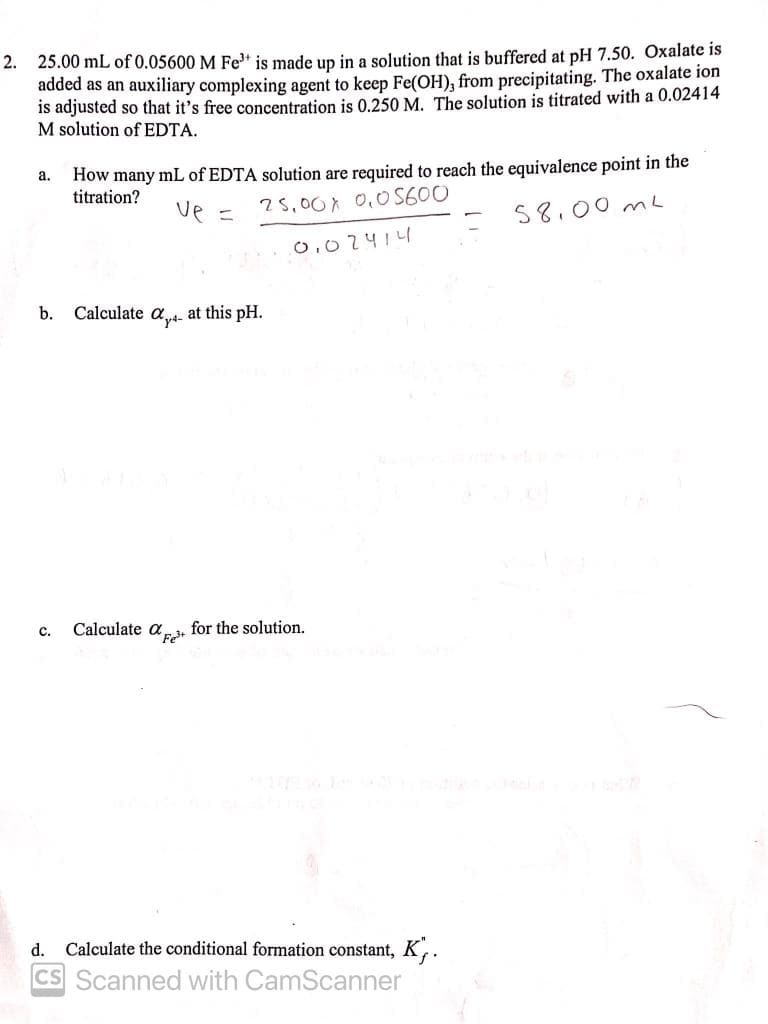2. 25.00 mL of 0.05600 M Fe" is made up in a solution that is buffered at pH 7.50. Oxalate is added as an auxiliary complexing agent to keep Fe(OH), from precipitating. The oxalate ion is adjusted so that it's free concentration is 0.250 M. The solution is titrated with a 0.02414 M solution of EDTA. How many mL of EDTA solution are required to reach the equivalence point in the titration? ve = 25,00 0.0 S600 58.00 mL O.02414 b. Calculate a„t- at this pH. Calculate a. for the solution. C.
2. 25.00 mL of 0.05600 M Fe" is made up in a solution that is buffered at pH 7.50. Oxalate is added as an auxiliary complexing agent to keep Fe(OH), from precipitating. The oxalate ion is adjusted so that it's free concentration is 0.250 M. The solution is titrated with a 0.02414 M solution of EDTA. How many mL of EDTA solution are required to reach the equivalence point in the titration? ve = 25,00 0.0 S600 58.00 mL O.02414 b. Calculate a„t- at this pH. Calculate a. for the solution. C.
Chapter11: Solving Equilibrium Problems For Complex Systems
Section: Chapter Questions
Problem 11.16QAP
Related questions
Question

Transcribed Image Text:2. 25.00 mL of 0.05600 M Fe" is made up in a solution that is buffered at pH 7.50. Oxalate is
added as an auxiliary complexing agent to keep Fe(OH), from precipitating. The oxalate ion
is adjusted so that it's free concentration is 0.250 M. The solution is titrated with a 0.02414
M solution of EDTA.
How many mL of EDTA solution are required to reach the equivalence point in the
titration?
а.
Ve =
25,007 0,0 S600
58.00 mL
0,02414
b.
Calculate a at this pH.
Calculate a
for the solution.
с.
d.
Calculate the conditional formation constant, K,.
CS Scanned with CamScanner
Expert Solution
This question has been solved!
Explore an expertly crafted, step-by-step solution for a thorough understanding of key concepts.
Step by step
Solved in 2 steps

Knowledge Booster
Learn more about
Need a deep-dive on the concept behind this application? Look no further. Learn more about this topic, chemistry and related others by exploring similar questions and additional content below.Recommended textbooks for you


Principles of Modern Chemistry
Chemistry
ISBN:
9781305079113
Author:
David W. Oxtoby, H. Pat Gillis, Laurie J. Butler
Publisher:
Cengage Learning

Chemical Principles in the Laboratory
Chemistry
ISBN:
9781305264434
Author:
Emil Slowinski, Wayne C. Wolsey, Robert Rossi
Publisher:
Brooks Cole


Principles of Modern Chemistry
Chemistry
ISBN:
9781305079113
Author:
David W. Oxtoby, H. Pat Gillis, Laurie J. Butler
Publisher:
Cengage Learning

Chemical Principles in the Laboratory
Chemistry
ISBN:
9781305264434
Author:
Emil Slowinski, Wayne C. Wolsey, Robert Rossi
Publisher:
Brooks Cole

Chemistry: Principles and Reactions
Chemistry
ISBN:
9781305079373
Author:
William L. Masterton, Cecile N. Hurley
Publisher:
Cengage Learning